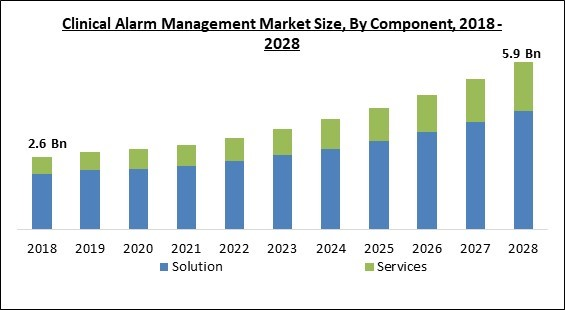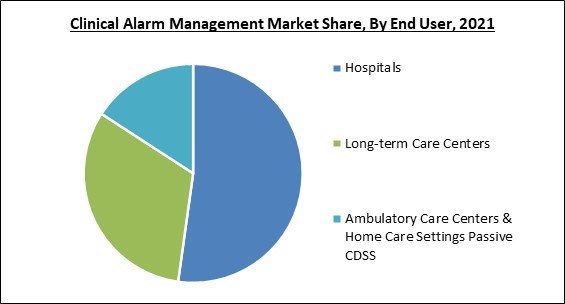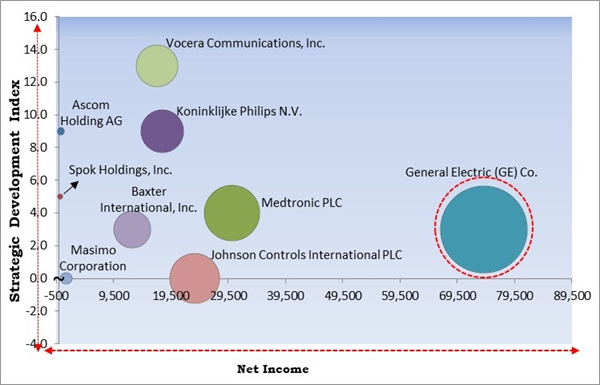The Global Clinical Alarm Management Market size is expected to reach $5.9 billion by 2028, rising at a market growth of 10.5% CAGR during the forecast period.
Alarms notify employees when a situation is dangerous or life-threatening and calls for rapid action, yet they frequently ring even when no such scenario exists. Most non-urgent alarms don't need to be attended to right away by a staff member. The persistent onslaught of nuisance alerts causes alarm fatigue, which is demonstrated by slow or no response, silencing or muting the alarm, or completely turning off the alarm. This cacophony creates the background noise of a unit's environment. The staff member may not be warned of an emergency if the alert is turned off or muffled.
Even though there are strategies, none of them by themselves can solve this issue. Multiple actions are needed for mitigation, some of which might need to be customized for the unit or patient. For instance, when necessary, alarm parameters may be changed to increase the likelihood that the alarm will only go off when the patient genuinely needs to be attended to. In some circumstances, it might also be able to place a small delay on the alarm; in such cases, things automatically adjust themselves after just a few seconds. Employing technicians to keep an eye on the patient monitors and notify staff of any events is another tactic. This advice piece examines these interventions in greater detail.
The major strategies followed by the market participants are Product Launches. Based on the Analysis presented in the Cardinal matrix; General Electric (GE) Co. is the major forerunner in the Clinical Alarm Management Market. Companies such as Vocera Communications, Inc., Koninklijke Philips N.V. and Ascom Holding AG are some of the key innovators in Clinical Alarm Management Market.
The market research report covers the analysis of key stake holders of the market. Key companies profiled in the report include Koninklijke Philips N.V., General Electric (GE) Co. (GE Healthcare), Ascom Holding AG Spok Holdings, Inc. (Spok, Inc.), Masimo Corporation, Cornell Communications, Inc., Baxter International, Inc., Johnson Controls International PLC, Medtronic PLC, and Vocera Communications, Inc. (Stryker Corporation).
Alarms notify employees when a situation is dangerous or life-threatening and calls for rapid action, yet they frequently ring even when no such scenario exists. Most non-urgent alarms don't need to be attended to right away by a staff member. The persistent onslaught of nuisance alerts causes alarm fatigue, which is demonstrated by slow or no response, silencing or muting the alarm, or completely turning off the alarm. This cacophony creates the background noise of a unit's environment. The staff member may not be warned of an emergency if the alert is turned off or muffled.
Even though there are strategies, none of them by themselves can solve this issue. Multiple actions are needed for mitigation, some of which might need to be customized for the unit or patient. For instance, when necessary, alarm parameters may be changed to increase the likelihood that the alarm will only go off when the patient genuinely needs to be attended to. In some circumstances, it might also be able to place a small delay on the alarm; in such cases, things automatically adjust themselves after just a few seconds. Employing technicians to keep an eye on the patient monitors and notify staff of any events is another tactic. This advice piece examines these interventions in greater detail.
COVID-19 Impact Analysis
Growth in Telehealth has been delayed over the last few years by legislative and behavioral constraints. The segment is expected to rise over the next two years, though, as many healthcare providers are now focusing on video conferencing and phone calls. Additionally, it significantly lessened the strain on hospitals that were already overwhelmed with COVID-19 patient counts. Medical IoT devices that reside in the patient's house are now utilized to maximize outpatient care and reduce follow-up visits; these devices can also be employed in an emergency.Market Growth Factors
The fatigue caused by alarms is increasing
The rise in alarm-based devices, patients connected to more devices, and a lack of device standardization have all contributed to an increase in the adoption of the clinical alarm management. Due to alarm fatigue brought on by the excessive frequency of alarms, medical staff may become desensitized, which could lead to alarms being disregarded or turned off. This could lead to overriding or avoiding potentially crucial notifications, with serious repercussions and a further burden on hospital resources in the future. Inaccurate and bothersome alarms can prevent patients from getting enough sleep and impede recovery, in addition to causing annoyance and stress for caregivers. The sector will rise as a result of increased government initiatives in both developed and developing nations for the use of clinical alarms.Increasing use of Electronic health records
Patient data included in electronic health records is frequently complex, private, and unstructured. To make use of the possibilities for bettering patient care, the barrier of integrating this knowledge into the process of providing healthcare must be overcome. Even though EHRs have been used for more than ten years, the market has accelerated because of national government initiatives targeted at enhancing patient protection. The context-specific data about the clinical care setting and patients will probably be used in the next phase of the EHR development process to enhance the relevance of reference content and alerts sent to patients at the point of treatment and to improve functionality. The growing adoption of Electronic health records surges the growth of the clinical alarm management market.Market Restraining Factors
Interoperability issues with the clinical alarm management
The lack of compatibility is a major obstacle to the successful delivery of clinical alarm management solutions and services. Electronic systems need to be able to communicate with one another to integrate and analyze data. Without adequate data interchange and analysis, clinical alarm management will not be effective. Approximately 10 percent of doctors were able to send, receive, and integrate health data into their respective EHR systems, according to the National Electronic Health Records Survey conducted between 2015 and 2017. The majority of hospitals are unable to perform all four information exchange activities, even though many of these hospitals can conduct some information exchange activities that support interoperability. The lack of the interoperability hampers the growth of the clinical alarm management market.Component Outlook
Based on the Component, the Clinical Alarm Management Market is segmented into Solutions and Services. The solution segment acquired the highest revenue share in the clinical alarm management market in 2021. It is due to the continual demand for software application upgrades and improvements. The greater proportion of this market can be due to the ongoing requirement for software application upgrades and enhancements. This is due to measures taken by important firms, the growing use of connected care technology in healthcare, and the requirement to lessen alert fatigue.Product Outlook
On the basis of Product, the Clinical Alarm Management Market is divided into Nurse call systems, Physiological monitors, EMR integration systems, Ventilators, Other. The nurse call system segment procured the largest revenue share in the clinical alarm management market in 2021. The significant market share can be attributed to the efforts of research organizations to lessen the risks of alarm exhaustion, the increase in the number of technically sophisticated nurse call systems introduced to the market, and the increased focus of healthcare providers on developing alarm management strategies to reduce alarm fatigue.End-user Outlook
By End-user, the Clinical Alarm Management Market is classified into Hospitals, Long-term care centers, and Ambulatory care centers & home care settings Passive CDSS. The long-term care centers segment registered a significant revenue share in the clinical alarm management market in 2021. It is because there are more senior living institutions and more people are becoming aware of the value of clinical alarm management solutions at these facilities. Alarm fatigue and safety have become crucial concerns in protecting patient safety. To find the fundamental cause and provide solutions, a multidisciplinary examination at the systems level is necessary.Regional Outlook
Region-wise, the Clinical Alarm Management Market is analyzed across North America, Europe, Asia Pacific, and LAMEA. The North America segment acquired the largest revenue share in the clinical alarm management market in 2021. It is because alarm fatigue cases are on the rise, and the government is working to reduce its effects, and healthcare IT systems are in high demand. As a result, the cause of this phenomenon is attributed to the fact that these systems provide reliability, efficient data maintenance, and data integrity, and facilitate the availability of patient data to authorized healthcare professionals.Cardinal Matrix-Clinical Alarm Management Market Competition Analysis
The major strategies followed by the market participants are Product Launches. Based on the Analysis presented in the Cardinal matrix; General Electric (GE) Co. is the major forerunner in the Clinical Alarm Management Market. Companies such as Vocera Communications, Inc., Koninklijke Philips N.V. and Ascom Holding AG are some of the key innovators in Clinical Alarm Management Market.
The market research report covers the analysis of key stake holders of the market. Key companies profiled in the report include Koninklijke Philips N.V., General Electric (GE) Co. (GE Healthcare), Ascom Holding AG Spok Holdings, Inc. (Spok, Inc.), Masimo Corporation, Cornell Communications, Inc., Baxter International, Inc., Johnson Controls International PLC, Medtronic PLC, and Vocera Communications, Inc. (Stryker Corporation).
Strategies deployed in Clinical Alarm Management Market
Partnerships, Collaborations and Agreements:
- Nov-2021: Vocera Communications signed an agreement with MDI Medical Limited, a provider of medical device solutions for diagnosis, monitoring, and preventive medicine. Through this agreement, MDI Medical would operate closely with Vocera to market the whole strategic clinical communication and cooperation solutions to the Irish industry.
- Sep-2021: Medtronic came into a partnership with Stasis Health Private Limited, a completely owned subsidiary of Stasis Labs. This partnership would rise up and extend the permit to their state-of-the-art Stasis Monitor, a connected upkeep bedside multi-parameter monitoring system. Moreover, the inclusion of Stasis Monitor in the Medtronic offering expands the organization's capacity to provide patients inside the hospital while delivering physicians the possibility to remotely inspect their patients.
Product Launches and Product Expansions:
- Jun-2022: GE Healthcare unveiled Portrait Mobile, a wireless patient surveillance system. The Portrait Mobile is developed to assist clinicians to detect premature patient deterioration and continuously monitoring patients’ health during their visits to the hospital.
- Jul-2021: Vocera Communications launched Vocera Edge, new cloud-based clinical communication and collaboration solution for smartphones. The Vocera Edge deliver consumers options for how they buy and deploy solutions. Moreover, the robust and safe solution is a genuine extension of Vocera's strategic vision and is especially well fitting to reach the speed and scale of each organization’s requirements to enhance patient safety, supervision, and experience.
Acquisition & Mergers:
- Jul-2022: Ascom took over Appliware, a French software developer. This acquisition would improve Ascom’s software offering with a state-of-the-art alarming and alerting solution and would additionally boost Ascom’s growth in workflow and software solutions.
- Jan-2021: Royal Philips completed the acquisition of Capsule Technologies, a foremost provider of medical device integration and data technologies. With this acquisition, the integration of Philip's dominant offering with Capsule’s foremost Medical Device Information Platform, linked through Philips’ secure vendor-neutral cloud-based HealthSuite digital platform, would improve and boost Philips’ patient care management solutions for complete care settings in the hospital, along with small patient care.
- Apr-2021: Vocera Communications completed the acquisition of PatientSafe Solutions, which allows care teams to communicate and work jointly efficiently and reliably through a mobile platform. This acquisition aimed to develop Vocera's spread into small and mid-size hospitals with a flexible and easy-to-use solution. Moreover, this transaction would also boost Vocera's evolution to the cloud and deliver possibilities to reinforce key relationships, developing communication and collaboration solutions to sustain more frontline employees across the spectrum of care.
- Aug-2020: Vocera Communications took over EASE Applications, which offers a cloud-based communication platform to enhance the patient experience by allowing family and friends members to obtain timely updates. This acquisition would reinforce the Vocera platform by improving caretaker interaction with patients and relatives.
Approvals and Trials:
- Sep-2022: Medtronic received FDA approval for its RespArray patient monitor. The latest system assists with the increased requirement for awareness for patients in procedural sedation and medical-surgical units as crew deficiencies and clinician burnout induced a reduction in patient protection.
- Mar-2022: Royal Philips received a 510(k) market clearance from U.S. Food & Drug Administration for the Philips Capsule Surveillance solution. The latest Philips Capsule Surveillance contains expanded integration into hospitals’ current mobile clinical communication and collaboration tools and electronic intensive care units, and virtual care population health management systems, delivering more transparency on live streaming waveforms, data, device alarms, and contextual signals.
- Jan-2022: Ascom received a medical device product certification for Digistat Care, an incorporated critical care patient and clinical alarm management system. The new Digistat Care is developed to sustain the daily movements of staff and assist achieve safer, more adequate care. Moreover, the Ascom Digistat offering is a complete modular portfolio of clinical workflow software and an evolved patient data management system for critical care divisions.
Scope of the Study
Market Segments Covered in the Report:
By Component
- Solution
- Services
By End User
- Hospitals
- Long-term Care Centers
- Ambulatory Care Centers & Home Care Settings Passive CDSS
By Product
- Nurse call systems
- Physiological Monitors
- EMR Integration Systems
- Ventilators
- Others
By Geography
- North America
- US
- Canada
- Mexico
- Rest of North America
- Europe
- Germany
- UK
- France
- Russia
- Spain
- Italy
- Rest of Europe
- Asia Pacific
- China
- Japan
- India
- South Korea
- Singapore
- Australia
- Rest of Asia Pacific
- LAMEA
- Brazil
- Argentina
- UAE
- Saudi Arabia
- South Africa
- Nigeria
- Rest of LAMEA
Key Market Players
List of Companies Profiled in the Report:
- Koninklijke Philips N.V.
- General Electric (GE) Co. (GE Healthcare)
- Ascom Holding AG
- Spok Holdings, Inc. (Spok, Inc.)
- Masimo Corporation
- Cornell Communications, Inc.
- Baxter International, Inc.
- Johnson Controls International PLC
- Medtronic PLC
- Vocera Communications, Inc. (Stryker Corporation)
Unique Offerings from the Publisher
- Exhaustive coverage
- The highest number of Market tables and figures
- Subscription-based model available
- Guaranteed best price
- Assured post sales research support with 10% customization free
Table of Contents
Chapter 1. Market Scope & Methodology
Chapter 2. Market Overview
Chapter 3. Competition Analysis - Global
Chapter 4. Global Clinical Alarm Management Market by Component
Chapter 5. Global Clinical Alarm Management Market by End User
Chapter 6. Global Clinical Alarm Management Market by Product
Chapter 7. Global Clinical Alarm Management Market by Region
Chapter 8. Company Profiles
Companies Mentioned
- Koninklijke Philips N.V.
- General Electric (GE) Co. (GE Healthcare)
- Ascom Holding AG
- Spok Holdings, Inc. (Spok, Inc.)
- Masimo Corporation
- Cornell Communications, Inc.
- Baxter International, Inc.
- Johnson Controls International PLC
- Medtronic PLC
- Vocera Communications, Inc. (Stryker Corporation)
Methodology

LOADING...











